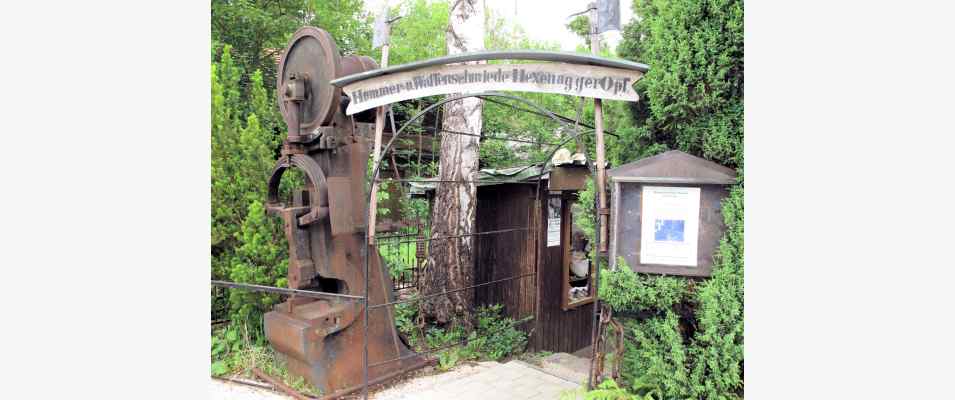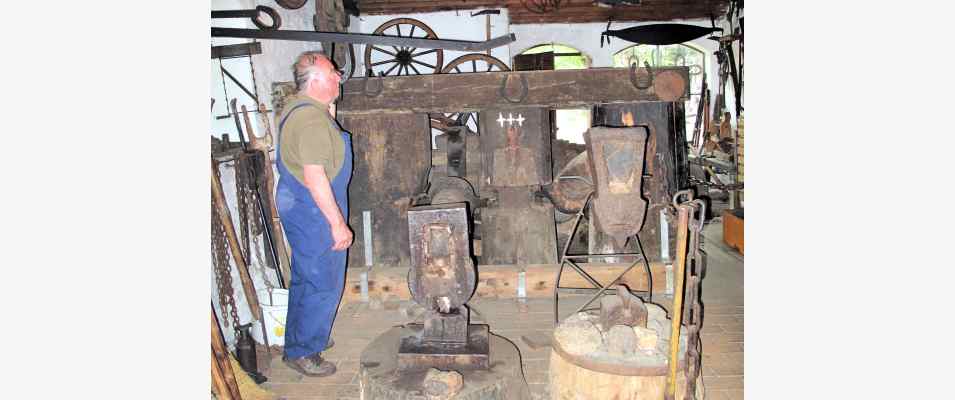




The Smithy (Armoury - Farriery - Forge)
in Altmannstein / Hexenagger in the national park Altmuehl valley
Long before the Romans conquered the land, the Celts had found iron ore and forged iron. "Celts´ slag", as it is called, was left by smelters. When the Romans built their Limes they fixed the boundary so that the mines of Schafshill were within their territory.
In a distance of about three miles from Hexenagger, there are the former opencast iron ore mines from which dogger ore was dug, containing 20% iron. The oldest documents concerning the forge date back to the 15th century. In about 1470 the dam and the forge were built. Ploughshares and swords and all kinds of sharp instruments of farmers and housewives were worked upon here.
In the 17th century iron manufacturing was thriving in the Upper Palatinate; there were about 350 forges, and local iron-mongers travelled as far as France and the Baltic Sea. In Hexenagger, Max Albert von Muggenthal was lord of the castle. lie was a farsighted man and supported the mines of Schafshill so that there was soon enough ore to supply other forges in the area of Riedenburg ![]() . Muggenthal invested 7000 florins in building a water-supply and -pumping station. The castle
. Muggenthal invested 7000 florins in building a water-supply and -pumping station. The castle ![]() high up on the hill had enough water; what had once to be carried uphill, was now pumped by a machine: thirty buckets an hour. The first station worked from 1693 to 1856; remnants of the pump made in the bronze foundry can be seen in the exhibition. After 1856 a two cylinder pressure pump and the 15 feet overshot water-wheel were installed, and they worked for a hundred years.
high up on the hill had enough water; what had once to be carried uphill, was now pumped by a machine: thirty buckets an hour. The first station worked from 1693 to 1856; remnants of the pump made in the bronze foundry can be seen in the exhibition. After 1856 a two cylinder pressure pump and the 15 feet overshot water-wheel were installed, and they worked for a hundred years.
Once there were 30 water-mills along the rivulet Schambach, but today the water wheels in Hexenagger are the last to turn round.
In the museum forge, visitors can see the old heavy mallets. Once there were seven fire-places; now only two of them are occasionally in full action when a bigger piece of work must be hammered.
In 1894 Charles Kleiss rented the forge from the lord of the manor. Kleiss´s son bought it in 1954, and his son-in-law Norbert Huber now manages the forge as a master smith and as a restorer. The ravages of time have seriously affected the smith’s shop, and it has taken a lot of time and a lot of money to restore buildings and machinery. The owners are also busy collecting old tools which will be shown in an exhibition. Visitors should have a look at some very rare objects:
Huns´ irons, i. e. medieval horseshoes,
bullock´s irons, i. e. shoes for oxen as draught-animals,
harness for horses and oxen,
cuirass anvil and beak-iron,
multiplex rat-traps and fox-traps.
And there are antique churns and butter-tubs, coffee-drums, pendulum-clocks, centrifugal machines, distaffs and spinning-wheels, pewters and copperkettles.
back to the Homepage of the town Altmannstein ![]()
Zuletzt aktualisiert am 10.02.2017